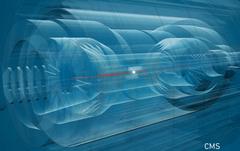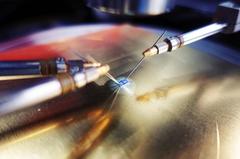URL: https://www.desy.de/news/news_search/index_eng.html
Breadcrumb Navigation
DESY News: CMS pushes the precision frontier
News
News from the DESY research centre
CMS pushes the precision frontier
Experiments at the Large Hadron Collider LHC at CERN explore the very basic elements of the Universe and their interactions at ever-increasing precision. At the precision frontier, new particles or forces beyond the standard model of particle physics could be discovered as small but significant discrepancies between theoretical predictions and experimental observations. With major contributions from DESY physicists, the CMS collaboration at the LHC has now published a new measurement of a crucial value, the so-called integrated luminosity, taking precision to a new level.

View of the proton beams (marked in red) colliding in the center of the CMS Experiment at the LHC at CERN (image: CERN).
The CMS collaboration has now divided this number by another factor of two: their new luminosity measurement with an uncertainty of 1.2 % is the most precise result at a high-energy and high-luminosity hadron collider experiment. The result was produced by a team of physicists and Ph.D. students at DESY and other research institutions. “Credit for this leap in quality goes especially to the Ph.D. students and PostDocs who developed ingenious and new methods, and tenaciously performed all the studies that shrunk the uncertainties to this unprecedented level”, says Andreas Meyer, DESY scientist in the CMS group. The new measurement marks a milestone in the quest for precision measurements at hadron colliders. It is also a proof of feasibility for the declared goal for the High-Luminosity-LHC era starting in 2027 to measure the luminosity to a precision of 1 %.
The full factor of two in precision is picked up by the most recent CMS measurement of the production of Z-bosons, messenger particles of the weak force. “With the new measurement more stringent experimental constraints on theory predictions become possible”, says Joscha Knolle (Univ. Gent), former Ph.D. student at DESY, and taking over in Fall 2021 as co-convener of the CMS luminosity working group.

A silicon sensor for the CMS Fast Beam Condition Monitor (BCM1F) during characterization at DESY (photo: DESY/J. Rübenach, CMS).
Article about the luminosity measurement on the CMS website
Reference
CMS Collaboration, „Precision luminosity measurement in proton-proton collisions at √s=13 TeV in 2015 and 2016 at CMS“, submitted to EPJC, arXiv:2104.01927



